The Gift of South Dakota
Subscriptions to South Dakota Magazine make great gifts!
Subscribe today — 1 year (6 issues) is just $29!
Warriors First
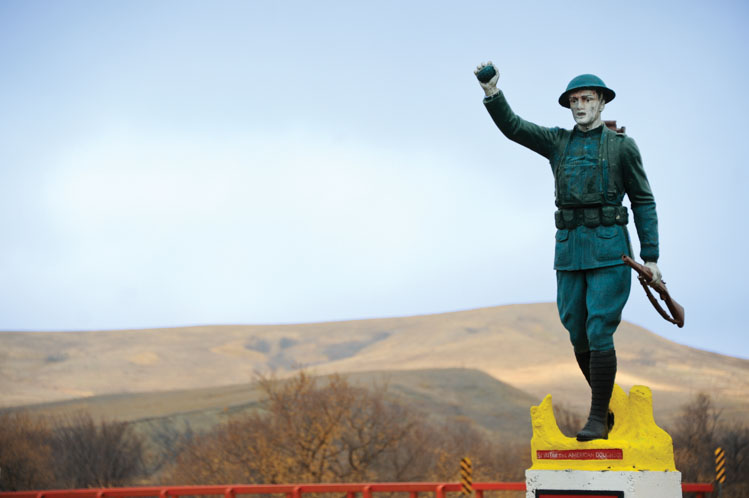 |
| The World War I doughboy statue at Rock Creek. |
Rock Creek is not a forgotten place. A town must be discovered before it’s forgotten, and most Americans — even most South Dakotans — have never heard of the town on the Standing Rock Reservation. Rock Creek is a dot on the state road map but it’s listed as Bullhead. The U.S. Postal Service still calls it Bullhead (zip code 57621). And road signs on nearby U.S. Highway 12 still point motorists to Bullhead.
“They changed the name to Rock Creek years ago,” says Joseph Montana, commander of the Brough-Brownotter American Legion Post 82, perhaps the most active organization in town other than the elementary school.
Montana believes the change occurred because Bullhead was the name of the man who shot Sitting Bull in 1890. Neither he nor any of the other 300 residents seem to mind what a visitor calls the town. They aren’t likely to correct you, even if you’re writing a story for a magazine.
The people of Rock Creek are busy enough with daily living. Visit on any weekday morning and you’ll hear the happy shrieks of children playing at Rock Creek School. Cowboys might be loading saddled horses onto stock trailers for a trip to the tribal pasture. A young career woman — perhaps a teacher or a nurse — may be fueling her small car at the only gas pump in front of a tiny, old store as rooster pheasants scurry through tall grass on the banks of a nearby creek.
“They know it’s hunting season,” laughed Ivan Brownotter, a community leader and historian, when we asked about the pheasants. “Hunting’s not allowed within a mile of town and when the shooting starts they know enough to come to town.”
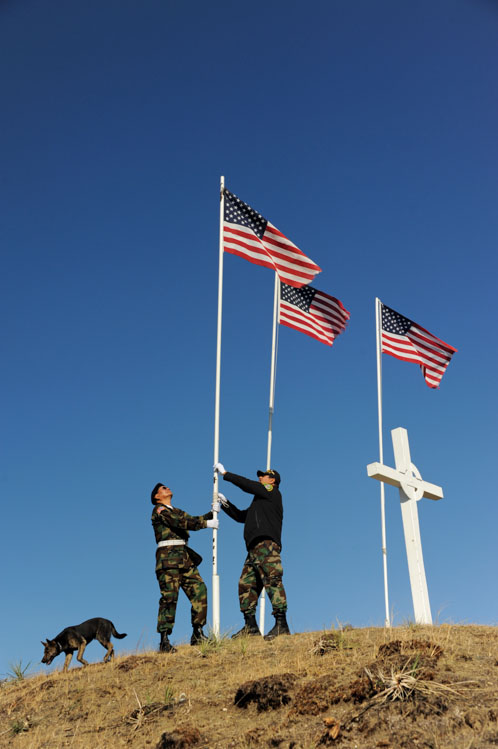 |
| Joseph Montana and Ivan Brownotter fly flags on a butte above the little reservation town of Rock Creek. |
Posed in the center of Rock Creek is a life-size image of a man with a rifle, a tribute to local soldiers who fought in World War I. Indiana artist E.M. Viquesney sculpted the infantryman and eventually produced more than 100 copies for courthouse squares, city halls and parks across the United States. He titled it The Spirit of the American Doughboy.
South Dakota’s only Viquesney doughboy is the one in Rock Creek. It was placed there in 1935, when the town was still Bullhead, after a $1,600 fundraising drive that culminated when Corson County Sheriff Charles Martin gave $500. The statue has been lovingly maintained in a tiny park with a bomb shell displayed over the entrance. Brownotter and other members of the Legion post recently transplanted ash saplings from the river to create a shady border.
Rock Creek has another unusual sight: Numerous tall steel flagpoles, created by a local welder and planted in cemeteries on the north and south ends of town, mark the graves of every deceased veteran since World War I.
The United States government has had a troubled relationship with Rock Creek and other towns on South Dakota’s nine reservations.Many residents trace their ancestries to Crazy Horse and Sitting Bull, two of American history’s most famous warriors who fought the U.S. military, and were killed — martyred in the eyes of the Lakota — as their people were being banished to hardscrabble prairies.
But their deaths and many other atrocities, disagreements, broken treaties and conflicts that divided the Lakota and the federal government have not deterred South Dakota’s Native Americans from signing up with the U.S. military, sometimes joining the very same units that wreaked destruction on their Native culture.
That’s not a mystery for Brownotter, who served in the Army in the 1980s and now devotes much of his spare time to the Legion post’s activities. He sees no contradiction to being a Native American in the military. “We love our country and we go to war to make sure our families are protected and so we can protect our culture and our heritage,” he says, while guiding us around town with Joseph Montana, his first cousin.
Montana came home to Rock Creek after serving in the U.S. Army and then living in Spokane, Washington. “My dad was Lincoln Hairy Chin and he was the commander when I was a boy,” he said. “He did all the work of painting and decorating the doughboy and he was the one who put the bomb up at the gate.”
***
The tradition of military service among Native Americans dates back to the Revolutionary War, when some Indians fought with the colonial army while others sided with the British. Indian men also served as scouts and trackers for the Union during the Civil War. In 1898, four women from the Standing Rock Reservation served the War Department as nurses in the Spanish American War. They belonged to the Congregation of American Sisters, a Catholic convent for Native women started by Father Francis Craft, the first priest ordained in Dakota Territory by legendary Bishop Martin Marty. Father Craft, who had Mohawk ancestry, spent 16 years in the territory and survived the 1890 Wounded Knee Massacre; he was attempting to defuse the conflict when the shooting began.
He and the four sisters worked at a military hospital in Jacksonville, Florida, and then were transferred to Havana, Cuba, where life must have seemed very foreign from the reservation prairie.
The Rev. Mother Mary Anthony, the leader of the sisters and a granddaughter of Chief Spotted Tail, died of tuberculosis in Cuba and was buried there with military honors by the Seventh Cavalry, the same regiment that was decimated at the Little Big Horn in 1876 and then killed 300 Indian men, women and children at Wounded Knee.
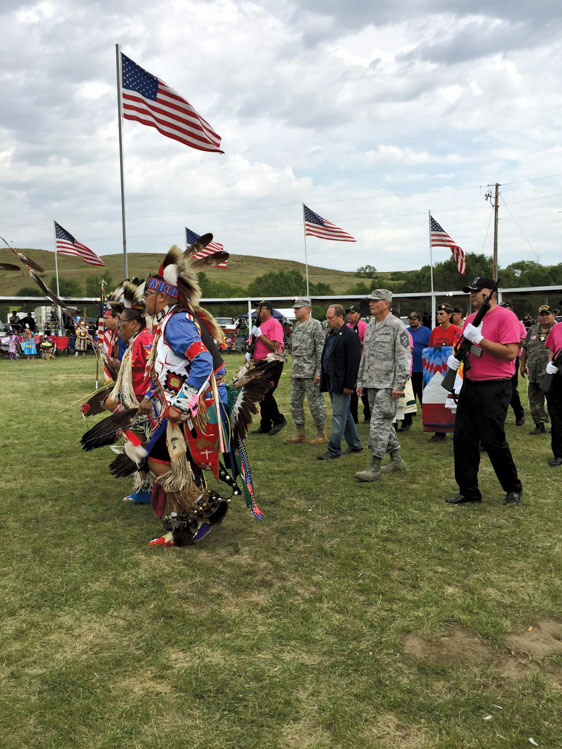 |
| Holidays for veterans highlight the social calendar at Rock Creek. Major Tim Reisch (back row, second from left) marched with Larry Zimmerman, the state Secretary of Veterans Affairs, in a Veterans Day pow wow. |
A generation later, U.S. military officials reached out to tribal leaders during World War I, asking them to encourage young men to join the fight against Germany and its allies. Robert Dunsmore, the veterans’ service officer for the Cheyenne River Indian Reservation, says oral history suggests that a general visited with a chief from the Standing Rock Reservation. “Then the chief sent runners to all the other tribes and told them it was OK for the men to go fight,” he says. “We were not even citizens of the United States at that time.”
The federal government had forbidden Indians to conduct traditional religious and cultural practices, such as the Sun Dance, and discouraged them from speaking their native language. Ironically, it was partly their language that captured the attention of some military leaders, who sought out bilingual Indians to transmit secret messages.
Little information can be found on the number of Native American soldiers who died during World War I, but among the 12,000 who served was Moses Clown, a young army private from Thunder Butte in Ziebach County. Forty-two years before Moses joined the army, his father, Amos, had fought Custer and the Seventh Cavalry at the Little Big Horn. His mother, Julia, was the sister of Crazy Horse, who said he would “fight to stay free (or) die a free Lakota if it comes to that.”
Crazy Horse’s death is well documented. Far fewer details are available of his nephew Moses’ death in 1918, but we know it happened during a battle in France, and that he received a hero’s burial in South Dakota. “None who witnessed the scene will ever forget it,” wrote the editor of the Dupree Leader. “The father, mother, brothers and sisters of the dead soldier, together with a large number of their friends, had gathered to await the coming of the train and as it came slowly to rest and the flag-covered coffin in the express car came into view, a great wail of sorrow went up from the waiting throng. As it was unloaded, the grief-stricken Indians gathered around with loud lamentations, laying hands and heads sadly and pitifully upon the flag.”
The next morning, Pvt. Clown’s body was buried several miles north of Thunder Butte, along a peaceful stretch of the Moreau River. The Dupree editor described the scene: “To the visitors it looked like a canvas city as their cars came into view over the summit of surrounding hills and descended to the river bank. In the center was a great teepee that had been specially constructed to contain the body. Its outer side was adorned in Indian fashion with illustrations of the tribal history and Old Glory floated beside at half mast.”
Many descendants of the young soldier still live in the shadow of legendary Thunder Butte — a promontory important to the Lakota and a natural landmark that mountain man Hugh Glass supposedly used to keep his bearings on his 1823 cross-country crawl to survival after being mauled by a grizzly bear.
The Cheyenne River Indian Reservation community of Thunder Butte, named for the nearby peak, has a few dozen houses, a church and school. Most of the residents are Clowns, and many of the grave markers in the cemetery bear that family name, which translates to heyoka in Lakota, meaning a wise person who teaches or leads by communicating in unusual ways.
All the Clowns of Thunder Butte know the history of the soldier who died in 1918, even 18-year-old Arnelle Clown who works as a nurse’s aide in Eagle Butte. She heard stories from older relatives, and has visited Moses’ grave in a small, private family plot several miles from town.
***
Moses Clown’s uncle, Crazy Horse, was killed in 1877 by U.S. soldiers at Fort Robinson in Nebraska. Thirteen years later, Sitting Bull was shot when a contingent of 39 tribal policemen tried to arrest the old warrior and holy man at his cabin because the U.S. military feared that he might join the Ghost Dance movement. Sitting Bull and his teenage son, Crow Foot, died during the botched arrest on Dec. 15, 1890 near the village now called Rock Creek.
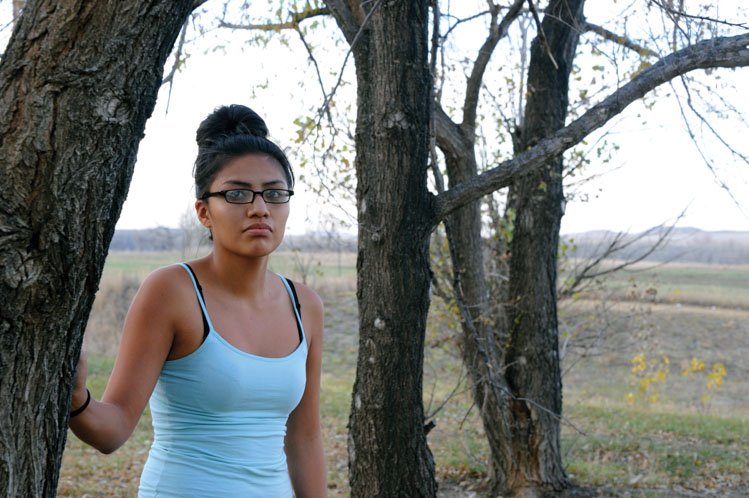 |
| Arnelle Clown and her extended family know the story of their ancestors' war history dating back to Crazy Horse. |
Historians believe the first bullet to hit Sitting Bull was fired by Lt. Henry Bullhead, the police leader who was also shot in the melee and died several days later. The community was later named in his honor, possibly by James McLaughlin, the longtime agent for the Standing Rock Reservation. A nearby town bears the name of McLaughlin.
Sitting Bull’s cabin was hauled away in 1893 for an exhibit at the World’s Fair in Chicago. Today a simple sign marks the spot along the Grand River, a few miles south of the community previously known as Bullhead.
The residents of Rock Creek never made an issue of their town’s former name — they just changed it and went on with life — but the history of the tribe over the past 150 years is complicated and contentious. Lakota leaders still clash with the U.S. government over health care, housing, education, law enforcement, taxation and the environment. A text of the 1868 Fort Laramie Treaty, which lists the Black Hills as part of the Great Sioux Reservation, is posted on the tribe’s website. In 2016, Standing Rock Reservation officials led a well-publicized protest over an oil pipeline in North Dakota. But it seems that neither historic nor current disagreements stifle the warrior mentality of serving and defending the homeland.
***
Rock Creek’s social calendar revolves around soldiers and veterans. On Memorial Day, the Brownotters, the Montanas and other veteran families hold services at six nearby cemeteries. Flags are hoisted on every veteran’s grave and an honor guard fires a salute. The second weekend of August is dedicated to a VJ Day pow wow, remembering the 1945 Japanese surrender that ended World War II.
The celebration includes Native dancing, races, tug-of-wars and other games. Teenagers re-enact the raising of the flag at Iwo Jima, and the Legion and auxiliary prepare several feasts. “We barbecue a whole cow for each meal,” says Brownotter. “We call it a waechujpi, which kinda means you should fill your plate more than once and then take some home with you.”
Adjutant General Tim Reisch experienced the reservation-style patriotism when he and several other officers of the South Dakota National Guard helicoptered into Rock Creek to participate in last year’s Veterans Day pow wow. “We saw great pride in the military,” he says. “The government conquered them and put them on reservations, broke the treaties, killed the buffalo herds and didn’t even provide them food. You could expect there’d be great animosity, but we see no animosity.”
Reisch agrees with Brownotter and others who credit the patriotism to a warrior culture. “Serving in the military fits their history where the warriors were highly revered. I know that a lot of Native Americans will go to active duty and then go back home, a veteran for life. They are proud of their service.”
Reisch served as sheriff of Miner County and head of the state Department of Corrections before assuming command of the state’s National Guard. “Back when I was in corrections I learned about the over-representation of Native Americans in our prisons, which is pretty disturbing.”
He hopes there may be opportunities in his current position to create more positive statistics. “Even before I had this job, the Guard was big on diversity. But we’ve really focused on it,” he said, pulling from the breast pocket of his uniform a plastic card that lists his nine priorities. Near the top — following family support, readiness and safety — is “Embrace Diversity,” which he describes as not just recruiting Native soldiers but going to great lengths to help them succeed.
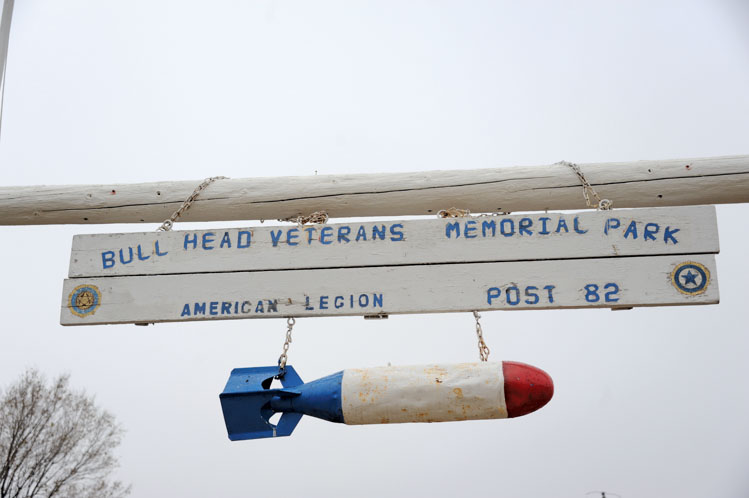 |
| A sign in Memorial Park at Rock Creek still refers to the town as Bullhead, its former name. |
“Every member of our organization needs to feel that they can make it to the top,” he says. “But if you look at the wall of pictures of generals and senior commanders in our headquarters and nobody there looks like you then you will feel you can’t be in one of those positions.” Under Reisch’s command, the number of Native American guardsmen and women has grown from 100 to 142, a 42 percent increase in seven years. The number of officers has grown from four to seven.
Most of the growth has occurred in the Army National Guard, probably because it has units in 22 towns, including many rural communities near reservations. The Army Guard has also worked on visible projects on the reservations, including hauling timber from the Black Hills for firewood, infrastructure missions and medical support.
Based in Sioux Falls, the Air Guard doesn’t have those outreach opportunities. “The Army Guard has two dozen recruiters and they are spread around the state. The Air Guard has two recruiters in Sioux Falls, and you end up recruiting people like the body of people that are already there — so we have to continue to make an effort to expand from that,” Reisch says.
Despite the Army Guard’s recent successes, Native Americans are under-represented: they constitute 8.9 percent of South Dakota’s population, but only 4.5 percent of the Guard. Native American participation appears to be slightly higher in the Army, Air Force, Navy and Marines based on figures from the state Department of Veterans Affairs indicating that 6.2 percent of the state’s 72,030 veterans are Native American.
***
Stories from Rock Creek and other reservation communities further illustrate why Native Americans embrace the warrior culture. Robert Dunsmore, the Cheyenne River Reservation veterans’ service officer, hears them daily.
“If not for code talkers in World War I and World War II and Korea, the U.S. might have lost those wars,” he says. “They were sworn to secrecy, and they kept their words so they never talked about it. We’ve heard there were at least 200 code talkers from South Dakota, but we’ve only identified 70 of them. That’s a part of our history we’ve lost.”
Ron Eagle Charging of Eagle Butte says his father was a code talker who never spoke of the experience but instructed his children on the warrior’s duty. “Boys in the family are taught to fight for those who can’t — the weak, the women, the less fortunate. Even if you have differences among warriors you still fight together. Crazy Horse and Sitting Bull never got along but they shared a purpose.”
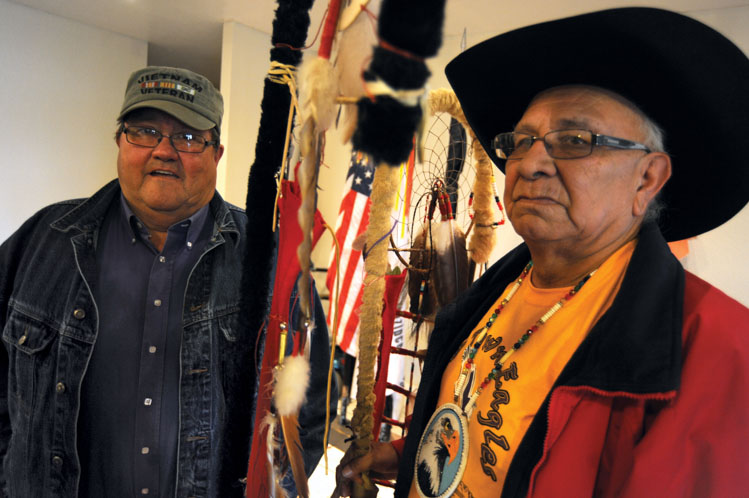 |
| Paul Lawrence (left) and Ron Eagle Charging of Eagle Butte say Native American veterans struggle for access to health care. |
Eagle Charging, 69, is one of several hundred Vietnam veterans on the Cheyenne River Reservation. He began his Vietnam tour as an ammunition specialist. “All I did was put the weapons together. We screwed the rocket heads on and loaded the helicopters.” Out of boredom and curiosity, he volunteered to be a door gunner on a helicopter, a position with a famously short lifespan.
Eagle Charging says he and other door gunners bolstered their courage by smoking marijuana laced with opium. “It made you so you’re not afraid to die,” he says, and it helped temporarily. But he came home with a severe case of post-traumatic stress disorder and diabetes, which he blames on Agent Orange.
Paul Lawrence, a fellow Vietnam veteran and a friend of Eagle Charging, lives with prostate cancer and diabetes. He says Native American veterans face special challenges, especially regarding PTSD. “They (Veterans Administration officials) like to blame the PTSD on the poverty and problems on the reservations instead of what happened to you in the war.”
Eagle Charging laughed in agreement: “To me PTSD is misnamed. Politicians made me sick. The P should be for the politicians.”
On the day we met the two Vietnam vets, they were planning to attend a meeting that was called to examine why the veterans clinic at Eagle Butte had suddenly closed. The story circulating around town was that the contract for the clinic had expired without any prior notification from the VA.
***
Cecilia Brownotter has received two Gold Stars from the U.S. government as recognition of family members lost in battle. Her brother, Joseph Hairy Chin, was killed in World War II, and a son, Dean, died in Vietnam in 1967. Five of her seven sons joined the U.S. military.
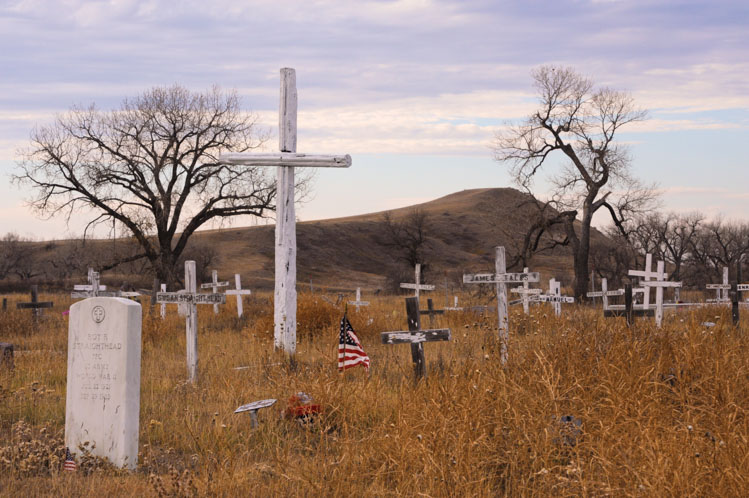 |
| A deceased soldier's marble headstone stands among several hundred graves that lie in a church cemetery at Thunder Butte. Wood crosses, many with names erased by the ravages of time and weather, mark most of the burial sites. |
Cecilia, 89, lives with relatives in a small house near Rock Creek’s doughboy. For years, her husband, Clayton, a World War II veteran, and his cousin Lincoln Hairy Chin tended to the statue. Clayton, a tribal councilman, was known as the guy who could raise the funds, while Lincoln preferred the more solitary work of brushing red, white and blue paints on a picket fence that surrounded the doughboy.
Today, the fence is gone. Now the little park features the sacred circle of the Lakota, formed in cement blocks painted white, yellow, red and black. The ash trees from the river valley are starting to grow.
Children at the school watch as adults show respect to the warrior vets with tree plantings, flag raisings and pow wows. Veterans also talk to the youth about the benefits of joining the military. “I tell the kids that you get to see the world,” Ivan Brownotter says. “You learn a trade and you have benefits that will help you further your education.”
He suspects his preaching probably has less impact than the annual events, especially the VJ Day re-enactment of Iwo Jima. “We always give the teenagers plastic guns and helmets and camouflage shirts,” says Brownotter. “We shoot fireworks as the flag goes up on the hill. There are always a few girls who join in. It’s impressive to watch.”
The re-enactment was started long ago when Lincoln Hairy Chin was commander of the Legion post in Rock Creek. Montana, his son, revived it when he returned from Spokane a few years ago to work with the local Head Start program. Montana also founded a group called Band of Brothers that organizes holiday dinners, dances, movie nights and other events for the people of Rock Creek.
The legacies of Crazy Horse and Sitting Bull may be partly responsible for a strong military tradition on the reservations, but the present-day service of Montana, Brownotter and their generation plays an even bigger role in how today’s Indian youth view the world that surrounds Rock Creek and zip code 57621.
Editor’s Note: This story is revised from the May/June 2017 issue of South Dakota Magazine. To order a copy or to subscribe, call (800) 456-5117.


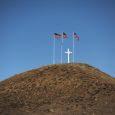

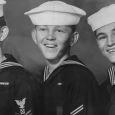
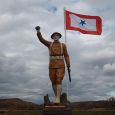
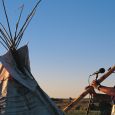
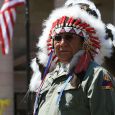


Comments